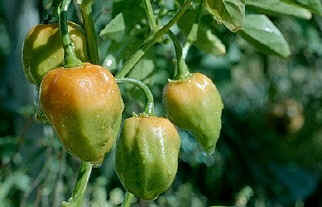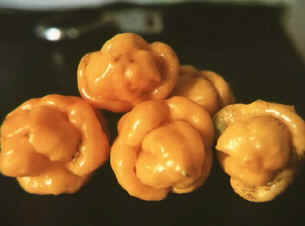
Editor’s Note: This short article appeared in the in-house newspaper of a company where I once worked. The piece was picked up on the AP wire and reproduced several times. I also heard that it received some kind of award, which was “accepted on my behalf” by some sort of PR flack, since, by that time, I had been laid off from the company, after 16 years of loyal service, by my fat, balding, rednecked Nazi of a boss (not that I’m bitter or anything, of course). If you’re interested in hot food, try the Ring of Fire group of Web sites.

One of nature’s more versatile plant species is the capsicum, which includes the red pepper, chili and paprika plants. A useful substance that is extracted from capsicums is capsaicin, which gives jalapenos their heat and is also used in medications.
The food industry uses high-performance liquid chromatography (HPLC) to measure capsaicin levels in peppers and pepper products. Originally, their pungency was assayed with a more primitive analytical tool — the human tongue. But as hot foods have grown in popularity, the scientists have gotten into the act, enabling food producers to measure capsaicin more precisely.
In the HPLC process, pepper extract is injected into a liquid stream, which is pumped under high pressure through an HPLC column. The column separates out the capsaicin compounds. After the separation, the compounds are exposed to a light beam. A detector measures how much the compound fluoresces — higher fluorescence equals higher pungency. Since capsaicin comprises more than one compound (called capsaicinoids), the HPLC reading results in a number of peaks, which are totaled to arrive at a pepper’s heat level.
In addition to its use in foods, capsaicin is purchased by the drug industry for medicines used to treat dermatological disorders, muscle aches and bruises. Researchers at Johns Hopkins’ Blaustein Pain Treatment Center are developing capsaicin-based salves that may yield weeks of relief from the leg pains suffered by AIDS patients.
Ferndale Laboratories in Ferndale, Michigan, produces topical analgesics for osteoarthritis and rheumatoid arthritis. Steve Northcott, Senior Manager of the Quality Control Laboratory uses a Perkin-Elmer Model 410 Pump, a 235 Detector and an ISS 200 Autosampler to analyze capsaicin extracted from red pepper seeds. This equipment is used in conjunction with Perkin-Elmer’s Turbochrom Data Handling Software to arrive at capsaicin percentages by weight in extracts purchased from vendors. The exact amount of capsaicin present in such extracts is critical to the effectiveness of the medications that Ferndale Labs produces. It is believed that the capsaicin reduces and eventually eliminates a chemical in the body that transmits pain messages from the skin and joints to the brain. The more this chemical is depleted, the less pain is perceived by the sufferer.
The demand for hot peppers is leading to increased R&D. Capsaicin can also be analyzed with Mass Spectroscopy equipment, used in conjunction with HPLC, as well as Gas Chromatography. Perkin-Elmer's Pecosphere 5x15C Silica Column is used by researchers to analyze piperine, a compound found in ground black pepper.
There is ongoing research aimed at altering the pepper’s DNA to genetically engineer even hotter varieties. Groups such as the Pepper Improvement Committee, which holds seminars at the National Pepper Conference, are looking into genetic engineering to control pepper viruses, infuse new genes into current varieties and increase yields. And for those people for whom the habanero pepper’s mouth-searing 300,000 Scoville units (refer to the scale below) is just not enough flavor, there is ongoing research in South America aimed at altering the pepper's DNA to genetically engineer even hotter varieties. So, perhaps one day, HPLC equipment may help to create the world’s hottest salsa.

At one time, peppers’ heat was rated on the Scoville Organoleptic Scale, developed by pharmacist Wilbur Scoville. He had volunteers taste extracted capsaicin diluted with sweetened water. Based on the amount of water needed to dilute the capsaicin until it could not be tasted, Scoville came up with a scale by which the world’s hot peppers are rated.
Food companies once used QC tasters to sample products as they came off the production line to see how they compared with preset heat levels memorized by the trained samplers. Individuals wrote down their ratings in Scoville units, and the results were averaged to see if the product line was deviating from desired standards. This subjective method has now been superseded by HPLC.
HPLC measurements of capsaicin in foods are expressed in ASTA units, named for the acronym of the American Spice Trade Association, an industry group that is a strong proponent of HPLC for food analysis. However, the ASTA has had little success convincing people to adopt the scale, so industry users commonly convert HPLC measurements into the older and more-widely accepted Scoville units. Below is a representative sample of the range of heat available to the adventurous consumer.
| Pepper | Pungency |
Bell Pepper |
0 |
Anaheim |
250–1,400 |
Poblano |
3,000 |
Jalapeno |
3,500–4,500 |
Hungarian yellow |
4,000 |
Serrano |
7,000–25,000 |
Chili de arbol |
15,000–30,000 |
Japanese chili |
20,00–30,000 |
Tabasco |
30,000–50,000 |
Zanzibar chili |
40,000–50,000 |
Japanese santaka |
50,000–60,000 |
Mombasa chili |
50,000–100,000 |
Cayenne |
100,000–105,000 |
Indian birdeye |
100,000–125,000 |
Japanese kumataka |
125,000–150,000 |
Habanero |
300,000 |
Click here to return to the Mark Drought home page.